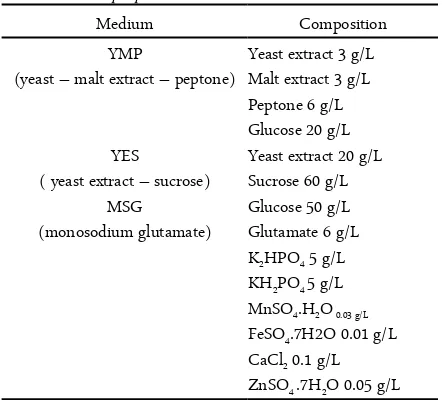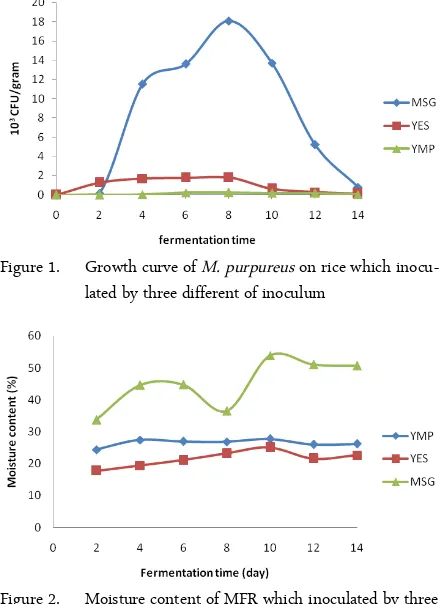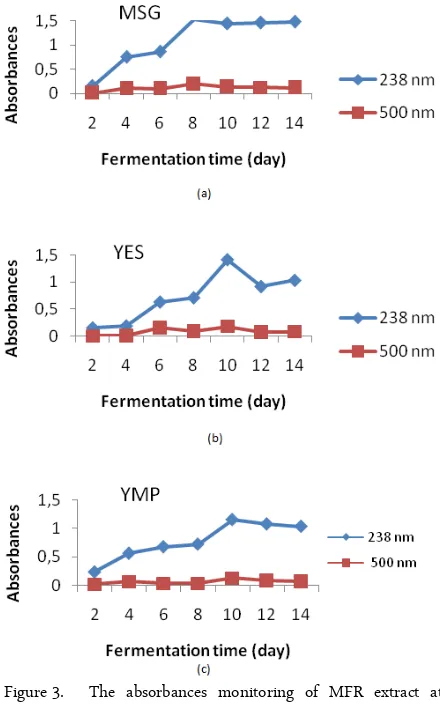THE JOURNAL OF TROPICAL LIFE SCIENCE OPEN ACCESS Freely available online
VOL. 6, NO. 3, pp. 170 - 175, September 2016 Submitted October 2015; Revised June 2016; Accepted September 2016
Inoculums Preparation and Detoxification Process in Monascus Fermented Rice Production
Marlia Singgih1, Nur Azizah Fitria1, Sri Priatni2*
1School of Pharmacy, Bandung Institute of Technology, Bandung, Indonesia
2
Research Unit for Clean Technology - Indonesian Institute of Sciences, Bandung, Indonesia
ABSTRACT
Monascus fermented rice (MFR), or angkak are well known for their ability to produce monacolin K, a statin compound that potential as a cholesterol-lowering agent. The objective of the research is to study the inoculum preparation and detoxification process in MFR production. In this study, the inoculum was prepared by cultivated M. purpureus HD001 in YMP, YES, and MSG medium. Rice was inoculated with 10% of inoculum and incubated at 30oC, for 14 days. The growth rate and moisture content of MFR were evaluated in the period from 0 to 14th day. The dried MFR was extracted with ethanol 95%, and the ratio of monacolin K/citrinin was estimated by measuring the absorbances of extract at λ238 (monacolin K) and λ500 (citrinin). MFR was detoxified by 0.1% v/v
of H2O2, at room temperature for one hour. Monacolin K and citrinin content in MFR extract was analyzed by
HPLC. Results showed that the growth of Monascus purpureus HD001 on rice which inoculated by MSG inocu-lum was faster than YES and YMP inocuinocu-lum. Maximum growth of M.purpureus occurs on the 8th day. The high-est moisture content also generated by MFR which inoculated by MSG inoculum. Maximum absorbance of mona-colin K (l238) of MFR which inoculated by MSG inoculum was obtained on the 8th day. HPLC data showed that detoxification of MFR with 0.1% H2O2 was able to reduce citrinin 58.45% and monacolin K 22.04%. After
treat-ment with 0.1% H2O2, ratio of monacolin K/citrinin in MFR samples was increased 1.87 times when compared to
before treatment.
Keywords: Monascus, monakolin-K, citrinin, cholesterol
Monascus spp. are well known in China and Asian countries for their ability to produce many bioactive, secondary metabolites including food pigments and traditional medicine, monacolin K [1]. Endo discovered that a more active methylated form of compaction known as monacolin K would be formed in the broths of Monascus ruber. Monacolin K, referred to as a statin compound, has been regarded as a cholesterol-lowering agent because it was proven to be a potent competitive inhibitor of HMG-CoA reductase [2]. Inhi-bition takes place due to structural homology between the biologically active form or statins, β-hydroxy acid and HMG-CoA, which is an intermediate of choles-terol biosynthesis pathway [3]. Heber et al. in Pat-tanagul et al. 2007 [4] reported that Monascus
fer-mented rice or angkak significantly decreased total cholesterol (TC), low-density lipoprotein cholesterol (LDL) and total triacylglycerol (TG) concentrations in human blood.
Angkak production may be contaminated by citrinin, a potent mycotoxin formerly known as monascidin which could damage kidney and liver. Some researchers have discovered and demonstrated that some strains of Monascus could produce citrinin, a nephrotoxin, which was previously found mainly in Aspergillus and Penicillium genera. Some studies consider that some actions should be taken to control citrinin concentration in fermented red rice [5]. Citrinin which was first isolated from Penicillium citrinum, is produced by more than ten kinds of fungi. Although citrinin is one of the well-characterized INTRODUCTION
*Corresponding author: Sri Priatni
Research Unit for Clean Technology - Indonesian Institute of Sciences
Jl. Sangkuriang, Bandung 40135, Indonesia Email: [email protected]
How to cite:
mycotoxins, information on its mechanism of toxic action is limited [6]. Citrinin comes from Monascus spp. mycelia extracts, which have antibiotic properties against gram-positive bacteria and embryotoxic, teratogenic, nephrotoxic, and hepatoxic effects on animals. This toxin will compromise the use of Monascus pigments as natural colorants. Consequently, many studies have been undertaken to prevent the formation of citrinin, and enhance the production of Monascus spp. moreover, its fungal metabolites (pigments or monacolin K) by biochemical and gene mutation on liquid fermentation [7]. Xu et al., 2005 [8] reported the use of YES and MSG medium in Monascus sp. 9901 cultivation, in order to know if Monascus sp. strain produces or not the citrinin. Results showed that the strain Monascus sp. 9901 was not detected in YES and MSG medium. This medium is usually used to test if the strains produce citrinin. The objective of the research is to study the influence of inoculum and detoxification process to monacolin k and citrinin content in monascus fermented rice (MFR). In this study, the inoculum was prepared by cultivated M. purpureus in YMP, YES, and MSG medium. Meanwhile, detoxification of MFR was carried out by using hydrogen peroxide.
Materials
Monascus purpureus HD001 from microbiology ITB culture collections, rice as solid substrates, mevinolin standard (Sigma-Aldrich) and other chemicals for culture media and analysis.
Inoculum cultivation of Monascus purpureus
The wild type M. purpureus HD001 was maintained in potato dextrose agar (PDA) slants. Ten mL suspension (A660= 0.25) of Monascus strain was
cultured in 100 mL in a sterile liquid medium (Table 1) and incubated in a shaker incubator (120 rpm), at 30oC for three days.
Solid fermentation of Monascus purpureus
100 g of rice was placed in an Erlenmeyer and autoclaved at 121oC for 15 minutes. The substrate was cooled and inoculated with 10% of Monascus inoculum. Solid fermentation of Monascus strain was carried out at 30oC, for 14 days, the substrate was supplemented with 2 mL of medium for three days and shook for every day. The growth rate of MFR with three different of inoculums was evaluated in the period from 0 day to 14th day. The rest of MFR was
Table 1. The composition of medium for inoculum cultivation of M. purpureus
Medium Composition
YMP
(yeast – malt extract – peptone)
Yeast extract 3 g/L
dried at 50oC for overnight.
Analysis of ratio monacolin K/citrinin by spectrophotometry
As much as 2 gr of MFR sample was extracted with 20 mL of ethanol 95% by shaking on a rotary shaker at 65oC, 100 rpm for 2 hours and the ethanol extract was separated by filtration. The ratio of monacolin K/citrinin was estimated by measuring the absorbances of ethanol extract on spectrophotometer UV-Vis at λ238 (monacolin K) and λ500 (citrinin).
Detoxification and extraction of sample for HPLC analysis
The dried of MFR was ground into finely powdered material using a blender. 2 g of MFR was treated with 10 mL 0.1% v/v of H2O2at room temperature for one
hour. After treatment, MFR powder was washed by aquadest for 2-3 times and dried at room temperature. 2 gram of MFR sample (before and after detoxification) was extracted with 20 mL of ethyl acetate pH 3 (added by H3PO485%) by shaking on a rotary shaker at room
temperature, 130 rpm for 2 hours. The ethyl acetate fraction was separated and neutralized by 5% of sodium carbonate. The ethyl acetate fraction was then evaporated by using a rotary vacuum evaporator.
Analysis of monacolin K
As much as 2.5 mg of mevinolin or monacolin K standard (Sigma-Aldrich) was dissolved in 250 µL of methanol (HPLC grade), and the extracted sample was dissolved in 500 µL. Monacolin K analysis was carried out by HPLC method based on Lee et al. 2006 [2] with
JTLS | J. Trop. Life. Science 172 Volume 6 | Number 3 | September| 2016
MATERIALS AND METHODS
modification. This method involved a Water system C18
column and the sample was eluted with acetonitrile/water (pH is adjusted to 2.5 with H3PO4)
at the ratio 55:45 by volume. The analysis was carried out at 28oC for 30 minutes; flow rates were 1 mL/min and detection with a UV detector at 238 nm.
Analysis of citrinin
As much as0.18 mg of citrinin standard (Sigma-Aldrich) was dissolved in 250 µL of methanol (HPLC grade), and the extracted sample was dissolved in 500 µL. This method involved a Water system C18column,
and the sample was eluted with acetonitrile and 0.2% H3PO4 at the ratio 1:1 by volume. Analysis was carried
out at 28oC for 20 minutes, flow rates were 1 mL/min and detection with a fluorescence detector at λex= 330 nm and λem = 500 nm.
Alternative culture media for Monascus fermenta-tion are very diverse, ranging from defined composi-tions to natural substrates. The cultivation of Monascus in solid-state fermentation (SSF) over steamed rice is very common. In some cases it is neces-sary to supplement these substrates with nutrients such as vitamins and organic nitrogen supplements. The components of the complex culture media include sug-ars, micronutrients, and organic nitrogen sources or in-organic nitrogen [9]. In this study, some formulated media such as MSG, YES and YMP (Table 1) were used for inoculum cultivation of M. purpureus. These media were used in inoculum preparation to evaluate the influences of its composition to monacolin k and citrinin content in Monascus fermented rice (MFR). The concentration of inoculum which added to rice as the substrate was adjusted by measuring the ab-sorbance at 660 nm. The data showed that inoculum which used YMP medium need three days cultivation, shorter than YES medium (6 days) and MSG (14 days). YES, and YMP medium contain high carbon (glucose, sucrose) and nitrogen (peptone, yeast extract) sources. The ratio of carbon and nitrogen (C/N) is very important in the growth of microbes and the me-tabolite production, both primer or secondary metabo-lite [10]. The inoculum of M.purpureus HD001 was added to the rice and fermentation was carried out for 14 days. During the fermentation, the growth of mi-crobes (TPC), moisture content and the absorbance of monacolin K/citrinin was monitored for every two days. The growth curve of MFR by using three differ-ent of inoculum cultivation (MSG, YES, and YMP) was
Figure 1. Growth curve of M. purpureus on rice which inocu-lated by three different of inoculum
Figure 2. Moisture content of MFR which inoculated by three different of inoculum
Figure 3. The absorbances monitoring of MFR extract at
l238 (monacolin K) and l500 (citrinin)
(70%) the substrate prevents oxygen penetration and facilitates the contamination, whereas the low mois-ture level inhibits the growth, enzyme activity and ac-cessibility to nutrients. In this study, showed that the growth of M. purpureus was influenced by moisture content of MFR.
Monascus fermented rice (MFR) has been regarded as a popular hypolipidemic because it contains mona-colin K. However, the safety of MFR is always an issue because citrinin is present in MFR [13]. In this study, the absorbance of monacolin K and citrinin of MFR was monitored by spectrophotometry method as the preliminary analysis.
Data on Figure 3a shown that the maximum absorbance of monacolin K (λ238) of MFR which
inoculated by MSG inoculum was obtained on the 8th day. Meanwhile, the highest absorbance of monacolin K of MFR which inoculated by YES and YMP inoculum was obtained on the 10th day (Figure 3b and c). However, the ratio of monacolin K/citrinin absorbances of MFR which produced by MSG
ino-Table 2. HPLC data of monacolin K and citrinin content of MFR product
Sample Monacolin K (µg/mg extract)
Citrinin (µg/mg extract)
Ratio Monacolin
/citrinin
Before treated 0.6968 0.0035 199.65 After treated 0.5432 0.0015 374.64
% decreasing 22.04 58.45
-culum on the 8th day (A238= 1.518 ± 0.019; A500= 0.197
± 0.003) was lower than MFR which produced by YMP inoculums (A238 = 0.720 ± 0.038; A500 = 0.038 ± 0.003).
Spectrophotometry is the simple method and suitable for data monitoring during the fermentation process. Monacolin K was detected by UV-spectrophotometry at maximum wavelength 238 nm [14], and citrinin was detected at maximum wavelength 500 nm [15]. Based on the data on figure 3, MFR which produced by MSG inoculum on the 8th day was selected for detoxification process by 0.1, %f H2O2. Analysis of citrinin content in
MFR was then analyzed by HPLC with a fluorescence detector. Citrinin has chromophore that possible detected by UV or fluorescence detector. However, fluorescence detector is more sensitive than UV detector. Fluorescence detectors offer high selectivity combined with superior limits of detection (LOD) compared to UV detectors. The fluorescence detector (FLD) is one of the most sensitive detectors in liquid chromatography. Both excitation and emission fluorescence spectra help to characterize individual compounds [16]. HPLC data of monacolin K and citrinin content in MFR before and after detoxification process was presented in Table 2.
Based on the data in Table 2, along with decreasing of citrinin content, monacolin K content was also decreased. Citrinin is the one of the well-known mycotoxins. A variety of chemicals, including acids, bases, oxidizing reagents, reducing agents, chlorinating agents, and miscellaneous reagents were tested to detoxify mycotoxins [6, 13]. Lee et al. 2007 [13] reported that citrinin could be removed at room temperature, and the amount of citrinin removed was increased with extended treating time. Treatment with 0.05% H2O2 was able to reduce citrinin by 54.5%, but
it also reduces the monacolin K by 92.7%. In this study, detoxification of MFR by 0.1% H
2O2 was able to reduce citrinin 58.45% and monacolin K 22.04%. After treatment, the ratio of monacolin K/citrinin was increased 1.87 times compared to before treatment with 0.1% H2O2. This data showed that hydrogen
peroxide more selective to citrinin rather than monacolin K. Fouler et al., 1994 [17] reported citrinin detoxification was treated by 0.05% H2O2 in 30
minutes. Moreover, Inayah et al., 2013 [18] reported that 1% H2O2 could degrade 89.50% of citrinin and
12.13% of pigment from liquid fermented of M. purpureus. Besides the presence of nutrients, the most important factors for growth and mycotoxin metabolism. In the process, they produce and secrete toxic secondary metabolite, such as mycotoxins [20].
We concluded that the best growth of M. pur-pureus HD 001 was obtained to rice which inoculated by MSG inoculum and maximum growth of M.pur-pureus occurs on the 8th
day. The highest moisture content also generated by MFR which inoculated by MSG inoculum. Maximum absorbance of monacolin K (λ238) of MFR which inoculated by MSG inoculum
was obtained on the 8th
day. HPLC data showed that detoxification of MFR with 0.1% H2O2 was able to
re-duce citrinin 58.45% and monacolin K 22.04%. After treatment with 0.1% H2O2, ratio of monacolin
K/cit-rinin in MFR samples was increased 1.87 times when compared to before treatment.
This research was funded by INSINAS 2013 project, Ministry of Research and Technology, which supported by School of Pharmacy ITB and Natural Products, Food and Pharmaceuticals Division – Research Centre for Chemistry (LIPI).
1. Chayawat J, Jareonkitmongkol S, Songsasen A and Yong-smith B (2009) Pigments and anti-cholesterol agent pro-duction by Monascus kaoliang KB9 and its colour mu-tants in rice solid cultures, Kasetsart J. (Nat. Sci.) 43: 696 – 702.
2. Lee CL, Wang JJ, Kuo SL, Pan TM (2006) Monascus fer-mentation of dioscorea for increasing the production of cholesterol-lowering agen monacolin K and antiinflamma-tion agent monascin. Appl Microbiol Biotechnol 72: 1254–1262.
3. Sayyad SA, Panda BP, Javed S and Ali M (2007)
Screen-ing of nutrient parameters for lovastatin by monascus pur-pureus mtcc 369 under submerged fermentation using placket burman design. Research Journal of Microbiology 2 (7): 601-605, ISSN 1816 4935.
4. Pattanagul P, Pinthong R, Phianmongkhol A, Leksawasdi N (2007) Review of angkak production (Monascus pur-pureus). Chiang Mai J. Sci. 34(3): 319-328.
5. Chen E, Hu X (2005) Study on red fermented rice with high concentration of monacolin K and low concentration of citrinin. International Journal of Food Microbiology 103: 331– 337.
6. Iwahashi H, Kitagawa E, Suzuki Y, Ueda Y, Ishizawa Y, Nobumasa H, Kuboki Y, Hosoda H and Iwahashi Y (2007) Evaluation of toxicity of the mycotoxin citrinin us-ing yeast ORF DNA microarray and oligo DNA microar-ray. BMC Genomics 8:95.
7. Chung CC, Chen HH and Hsieh PC (2008) Optimization of the Monascus purpureus fermentation process based on multiple performance characteristics. ISSN 1028-9488 Journal of Grey System 11(2): 85-96.
8. Xu G, Yue C, Yun C, Xiaorong L, Xing L (2005) Produc-tion of monacolin K in solid state fermentaProduc-tion of Monascus 9901 that does not produce citrinin. Industrial Biotechnology of Ministry of Education. www.agriqua.-doae.go.th/worldfermentedfood/P16_Xu.pdf
9. Carvalho JC, Oishi BO, Woiciechowski AL, Pandey A, Babitha S & Soccol CR (2007) Effect of substrates on the production of Monascus biopigments by solid-state fer-mentation and pigment extraction using different solvents. Indian Journal of Biotechnology 6: 194-199.
10. Prince I and Tribe D (1990) Fermentation Technology ASEAN- Australian Biotechnology Project. Bangkok 2.2-2.5, 3.2, 3.15
11. Udeh HO and Kgatla TE (2013) Review: Role of magne-sium ions on yeast performance during very high gravity fermentation. J. Brewing and Distilling 4(2): 19-45. 12. Maurya DP, Singh D, Pratap D, Maurya JP (2012)
Opti-mization of solid state fermentation conditions for the production of cellulase by Trichoderma reesei J. Environ. Biol. 33: 5-8.
13. Lee CL, Chen WP, Wang JJ, Pan TM (2007) A simple and rapid approach for removing citrinin while retaining monacolin k in red mold rice. J. Agric. Food Chem 55: 11101–11108.
14. Sun JL, Zou X, Liu AY, Xiao TF (2011) Eleveated yield of monacolin K in Monascus purpureus by fungal elicitor and mutagenesis of UV and LiCl. Biomedical Journals 44: 377-382.
15. Shimizu T, Kinoshita H, Ishihara S, Sakai K, Nagai S, Ni-hira T (2005) Polyketide synthase gene responsible for cit-rinin biosynthesis in Monascus purpureus. Applied and CONCLUSION
ACKNOWLEDGMENT
Environmental Microbiology 71(7): 3453-3457.
16. Schuster R and Schulenberg-Schell H (2000) A new ap-proach to lower limits of detection and easy spectral anal-ysis Applications of fluorescence detection in liquid chro-matography. Agilent Technologies.
17. Fouler SG, Trivedi AB, and Kitabatake N (1994) Detoxifi-cation of citrinin and ochratoxin A by hydrogen peroxide. Journal of AOAC International 77: 631-637.
18. Inayah I, Wibowo MS, Julianti E (2013) Citrinin degrada-tion in liquid fermentadegrada-tion broth of monascus purpureus
by hydrogen peroxide. Jurnal Matematika & Sains 18 (3): 93-98.
19. Zaki MM, El-Midany SA, Shaheen HM Rizzi L (2012) Mycotoxins in animals: Occurrence, effects, prevention and management. Journal of Toxicology and Environ-mental Health Sciences 4(1): 13-28.
20. Pascual-Ahuir A, Vanacloig-Pedros E and Proft M (2014) Toxicity mechanisms of the food contaminant citrinin. Application of a Quantitative Yeast Model. Nutrients 6: 2077-2087.


